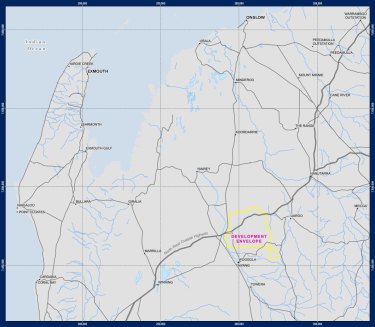“Renewable energy is now, in many cases, the lowest-cost form of energy available, making its uptake a contributor to financial performance as well as climate health,” the company said in its submission to the EPA.
“The proposal will demonstrate the viability of zero-carbon technologies in fuelling commercial-scale operations and will encourage other proponents to follow suit.”
Rio Tinto announced in late 2021 that it would spend about $2.1 billion ($US1.5 billion) on one gigawatt of wind and solar energy in the Pilbara, indicating that the 5.4-gigawatt Uaroo hub could cost more than $10 billion.
The hub’s planned solar generation capacity of 3.33 gigawatts is almost 2.5 times the total capacity of rooftop panels on WA’s south-west power grid.
The 340 wind turbines, with blade tips as high as 250 metres, could generate a maximum of 2.04 gigawatts, nine times more than WA’s biggest wind farm, Yandin.
To provide a consistent flow of power to Fortescue’s mining operations from the variable solar and wind generation, the hub would include a battery with a storage capacity of 9100 megawatt-hours: 45 times larger than the $155 million battery state-owned Synergy is installing at Kwinana, south of Perth.
In line with past trends, battery prices are likely to decrease over the seven years of progressive construction and commissioning Fortescue plans.

The Uaroo renewable energy hub has a lower cyclone risk than areas near the coast.Credit:Fortescue
Heidi Lee, chief executive of green industry advocacy group Beyond Zero Emissions, said the use of renewable energy to power heavy industry showed the Australian economy could be transformed into an economic powerhouse in the zero-emissions future.
“Australia could grow a new green export market worth $333 billion a year by 2050 by switching to renewable energy, selling green steel, green aluminium, renewable hydrogen and ammonia, critical minerals and batteries to the world,” she said.
“That’s almost triple the value of our current fossil fuel exports.
Loading
“Australia is perfectly placed with the renewables, raw materials and skills to meet the demand for the products that will power the future.”
Fortescue’s Uaroo hub 120 kilometres south of the coastal town of Onslow will span the Uaroo and Emu Creek cattle stations. Uaroo station is owned by Harvest Road, the beef subsidiary of Dr Forrest’s private company Tattarang.
The location that straddles the North West Coastal Highway was chosen for its wind and solar resources, proximity to Fortescue’s operations, relatively flat terrain and a lower cyclone risk than locations closer to the coast.
A construction camp for 1600 workers is planned and up to 100 people will be needed to operate the hub.
Moving long wind turbine blades and towers to site will be a huge logistical challenge. Fortescue is considering trucking the components from either Ashburton Port west of Onslow, or Port Hedland.
Fortescue is negotiating with the Thalanyji people who are the determined native titleholders for the area.
A 220-kilovolt transmission line to Fortescue’s Eliwana mine 170 kilometres away was not included in the EPA submission.








